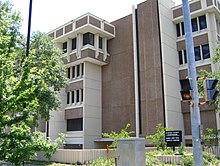Cultural facilities include the Florida Museum of Natural History, Harn Museum of Art, the Hippodrome State Theatre, and the Curtis M. Phillips Center for the Performing Arts. Smaller theaters include the Acrosstown Repertory Theatre (ART) and the Gainesville Community Playhouse (GCP). GCP is the oldest community theater group in Florida; in 2006, it christened a new theater building.[129]
The presence of a major university enhances the city's opportunities for cultural lifestyles. The University of Florida College of the Arts[130] is the umbrella college for the School of Music, School of Theatre and Dance, School of Art and Art History, and a number of other programs and centers including The University Galleries, the Center for World Art, and Digital Worlds. Collectively, the College offers many performance events and artist/lecture opportunities for students and the greater Gainesville community, the majority of which are offered at little or no cost.
Since 1989, Gainesville has been home to Theatre Strike Force, the University of Florida's premier improv troupe. In addition Gainesville also plays host to several sketch comedy troupes and stand-up comedians.
In April 2003, Gainesville became known as the "Healthiest Community in America" when it achieved the only "Gold Well City" award given by the Wellness Councils of America (WELCOA).[131] Headed up by Gainesville Health & Fitness Centers, and with the support of Shands HealthCare and the Gainesville Area Chamber of Commerce, 21 businesses comprising 60 percent of the city's workforce became involved in the "Gold Well City" effort. As of July 2011, Gainesville remained the only city in the country to reach the achievement.
The counties surrounding Alachua County vote strongly Republican, while Alachua County votes strongly Democratic.[132] In the 2008 election, there was a 22% gap in votes in Alachua County between Barack Obama and John McCain, while the remaining eleven candidates on the ballot and write-in votes received approximately 1.46% of the vote.[133]
Marijuana culture
Gainesville is renowned in the recreational drug culture for "Gainesville Green", a particularly potent strain of marijuana. Orange and Blue magazine published a feature article in 2003 about the history of Gainesville Green and the local marijuana culture in general.[134] In the mid-1990s, several Gainesville Hemp Festivals took place outside of the Alachua County courthouse.Music scene
Gainesville is well known for its music scene and has spawned a number of bands and musicians, including Tom Petty and the Heartbreakers, Stephen Stills, Don Felder and Bernie Leadon of The Eagles, The Motels, Against Me!, Charles Bradley, Less Than Jake, Hot Water Music, Loyal Revival, John Vanderslice, Sister Hazel, Hundred Waters, and For Squirrels. It is also currently the location of independent labels No Idea Records and Elestial Sound, and it is also the former home of Plan-It-X Records, which moved to Bloomington, Indiana. For two years, the Gainesville non-profit Harvest of Hope Foundation hosted the Harvest of Hope Festival in St. Augustine, Florida.[135] Gainesville is also the home of www.FLAROCKS.com, the founders of 'Santa Jam' who hold concerts every December throughout North Florida as a toy fundraiser for sick, injured, and homeless children, as well as being a local musician showcase. Since 2011 they have distributed nearly 700 toys to hospitals, local churches & homeless charities, and to needy families across the area.No Idea Records puts on an annual three-day rock festival known as The Fest, which typically occurs during the last weekend in October, coinciding with the annual Florida-Georgia football game (played in Jacksonville) to minimize tensions between the largely out of town music festival goers with the University of Florida students and alumni.[136]
Between 1987 and 1998, Gainesville had a very active rock music scene, with Hollywood star River Phoenix having the local club Hardback Cafe as his main base. Phoenix's band Aleka's Attic was a constant feature of the rock scene, among others.[137] The Phoenix family is still a presence in Gainesville with Rain Phoenix's band Papercranes and Liberty Phoenix's store, Indigo.[138]
Today, Gainesville is still known for its strong music community and was named "Best Place to Start a Band in the United States" by Blender magazine in March 2008.[139] The article cited the large student population, cheap rent, and friendly venues as reasons.
Over the past decade, Gainesville has been home to a wide variety of bands, from the Latin/afrobeat sounds of Umoja Orchestra, to the rock of Morningbell, to ska staples The Know How.[140]
Gainesville's reputation as an independent music mecca can be traced back to 1984 when a local music video station was brought on the air. The station was called TV-69, broadcast on UHF 69 and was owned by Cozzin Communications.[141] The channel drew considerable media attention thanks to its promotion by famous comedian Bill Cosby, who was part-owner of that station when it started. TV-69 featured many videos by punk and indie-label bands and had several locally produced videos ("Clone Love" by a local parody band, and a Dinosaur Jr. song).
Sports
The Florida Gators is the varsity team of the University of Florida, and competes at the Southeastern Conference of the National Collegiate Athletic Association since 1933. It has been ranked in the top 10 in the NACDA ranking since the 1983–84 season. it has won 32 national team championships, including two men's basketball titles, three football titles, four men's golf titles, and six women's tennis titles.The Gainesville Raceway is a dragstrip opened in 1969 that hosts the Gatornationals, one of the four NHRA major races.
Annual cultural events
- The Spring Arts Festival, hosted each year, usually in early April, by Santa Fe College (formerly Santa Fe Community College), is one of the three largest annual events in Gainesville and is known for its high quality, unique artwork.[142]
- The nationally recognized The Downtown Festival and Art Show, hosted each fall by the City of Gainesville, attracts award-winning artists and draws a crowd of more than 100,000.[143]
- The Hoggetowne Medieval Faire has attracted thousands of fairgoers for over 20 years.[144]
- The Gainesville Improv Festival provides a venue for new talent.




